The power of technology is that there are many ways to achieve a given outcome. At the $10M ANA Avatar XPRIZE Finals – the first live finals held by XPRIZE since 2004 – teams from around the world put their distinct robotic avatars head-to-head for the grand prize. “What struck me was how different everybody’s solutions were,” says Avatar XPRIZE technical lead Jacki Morie, who was there in Long Beach California at the Finals on the day.
She puts the team’s many approaches down to the fact that we are only at very the beginning of avatar technology – a technology that will one day let us connect, share our critical skills, and explore new places remotely, as though we were there in the flesh. This meant that, venturing into this new realm of technology over the last four years of the Prize, teams discovered there was no “off-the-shelf solution”. Instead, they had to use their knowledge from their respective fields of expertise – from haptics to robotics to designing operating systems – in order to build their robots.
“They all developed their avatar systems in their own neck of the woods, with input from their own fields, meaning no two robots were alike,” says Morie. What’s exciting, she adds, is the directions these new technologies will go in – in both the near and distant future.

Pictured: Robots from all 17 finalist teams line up for a group photo on the ANA Avatar XPRIZE testing course.
What the judges were looking for
At the Finals, Judges were ranking teams on three main criteria: advanced mobility, haptics, manipulation, and interaction tasks across three different domains: Connectivity (human-to-human connection), Exploration (the new era of travel), and Skills Transfer (expertise with no boundaries).
With ANA Airlines the sponsor of the competition, connectivity was an important factor in judging the 17 teams’ avatars, because ANA's business is about connecting people.
With “embedded judges” actually becoming parts of the competing teams and learning to operate the avatar systems, they were able to judge how easy the operating systems were to use under instruction. Having embedded judges also meant that teams were able to gather observational data – data that can help them improve their model's useability in the next stage.
The winning teams
With their impressively fast time on our test course, and completion of the tasks set out by the judges, NimbRo of Bonn, Germany, was the $5M grand-grand prize winner in the competition.
Second place was awarded to Pollen Robotics of Bordeaux, France, who scooped the $2M runner-up Prize, and third, Team Northeastern of Boston, Massachusetts third, awarded $1M.
“The three finalist teams took the Prize due to the ease of use of their operator systems – this was the challenge – to have someone else operate your robots,” says Morie. “The judges operating the winning tech said it was as easy as moving his own two hands around – it was as if that operator was inside the robots.”
Time was also a factor that was going to break any ties in the scoring. “Teams could make the perfect score of 15 – but they were also judged on speed. Not just how fast can the mobile avatar can move – but if it was simple to operate, then time was less of a factor. If the controller didn't have to think too much about how to use the system then they could focus on looking where their avatar was going.”
There were other teams that could have placed, says Morie, but they encountered technical difficulties on the course. “What we have to remember is that because this tech is brand new in some ways, we’re still trying to figure out best practices.”

Pictured: Team NimbRo's avatar completes tasks on the testing course in record-breaking time, moments before claiming the grand prize winner title.
What did we learn about the future of avatar technology?
Between the Semi-Finals and the Finals testing, a few big lessons became clear to the teams and judges:
Faces are important: We want the avatar to be the thing that connected the operators and recipient at a distance. To have that connection, we need some sort of face, says Morie, because it adds a sense of human connectivity.
Legs don’t really matter: “Legs present another level of challenge – if you’re going to get more humanoid robots or uneven terrain, then you are going to need legs that add complexity to the operator system. But they are harder to balance, and the headset POV can make you feel sick if the avatar is not stable. That’s why we didn't see the legged entries get into the top three slots.”
How teams train the operator is critical: Teams had one hour to train the operator judge. “If it takes 55 minutes to train them, that means you have a very complicated system,” says Morie. “The easier the system, the faster to train the operator – this was the defining feature of the winning teams.” Less training time results in more practice time before the actual test course run, too.
So, if teams take any lessons away from this competition, it’s about how easy it is for the operator to learn a system, says Morie. If it’s too much cognitive load, then you lose some of that sense of connection. “I hope that many of the teams get that down – more than they need to get some of the technical components down. That is the singular thing that will make widespread adoption of this technology real.”

Pictured: Judge Peggy Wu in the Team Northeastern control room.
The next steps
We are at an inflection point where we are starting to look at robots not just for the sake of robots, but for the benefit of humanity. The human thought process which isn’t yet there in artificial intelligence – critical thinking, creativity, decision making – so that’s where avatars are going to come in handy. What avatars offer us is a robot that is working in tandem with a human – combining the best of what humans bring and the best of what a robot or surrogate can bring.
“We have a long way to go, but we have a great start,” concludes Morie. “This technology can be exciting and useful and give us all ways to connect, travel and share our expertise – ways that we don’t have right now.”
Morie hopes we can test this technology again in two to three years to see what progress we have made and see how the lessons from the ANA Avatar XPRIZE have paid off. In the meantime, the teams proved not just that there are many ways to build an avatar, but many uses for these machines in the future, as they continue to evolve.
In case you missed it, catch up with the live stream now to watch the finalist teams’ avatars battle it out on our test course, complete with live commentary: watch the livestream here.